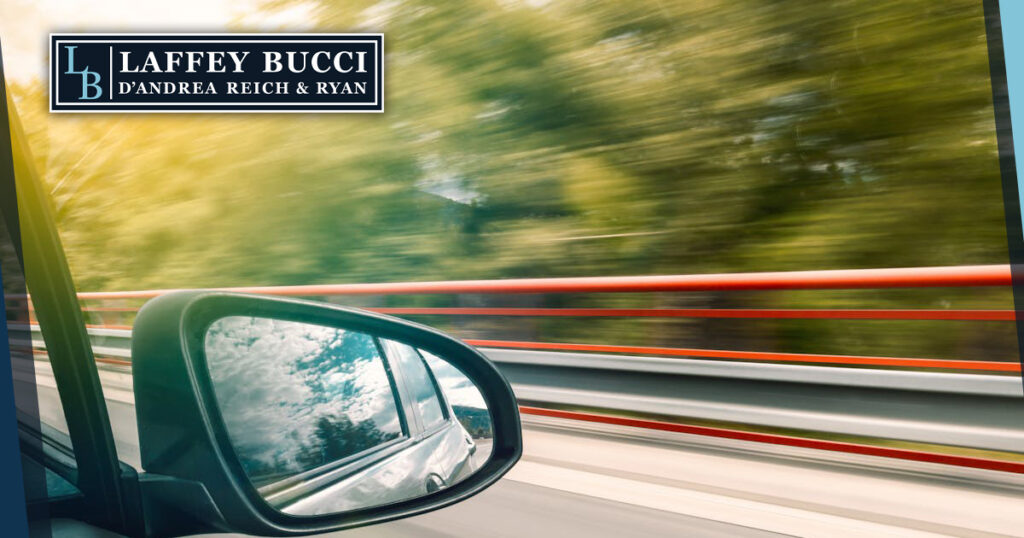After an accident, you need to determine the fault to help with your insurance and legal claims. Also, this can help to make sure the person responsible for your property damage and injuries compensates you for those losses.
According to the Pennsylvania Department of Transportation, there were 110,382 reportable traffic crashes in 2023. In New Jersey, the latest data shows 221,259 accidents in 2021, per the New Jersey Department of Transportation.
At Laffey Bucci D’Andrea Reich & Ryan, we have handled many car accident claims and know what can help liability in these accidents. Here is how you can tell if the other driver was at fault for a car crash you had in Philadelphia or its suburbs.
Were There Any Citations Issued?
If the other driver was issued any citations or tickets, that could be a clear indication that they were at fault for the crash. Violations that involve running a red light, failing to yield, or engaging in other illegal driving behaviors are signs that the other driver was at fault. Traffic violations are signs of negligence or reckless behavior, which can help establish liability. However, keep in mind that there are nuances in these cases. A ticket can also be disputed; in some cases, both parties may share fault for the accident.
Check Your Police Report
The police report is one of the most important pieces of evidence in any case. Police officers are trained to assess accident scenes, interview witnesses, and analyze the evidence so they can determine fault. In the report, you will find a summary of the accident, any citations issued, witness statements, and the officer’s opinion on who was at fault. A police report does carry weight with insurance companies and in court. If the report indicates that the other driver was at fault, you can use that to strengthen your case.
Collect Witness Testimonies
Additionally, witnesses can play a role in determining fault in a car crash. If bystanders or other drivers saw the accident, their statements can provide a third-party account of what happened. Many times, your legal team can use these testimonies to corroborate your version of events, helping to establish that the other driver was at fault.
For that reason, you should always collect witnesses’ contact details while at the crash scene. These statements may be needed later for insurance claims or legal proceedings.
Gather Photographic and Video Evidence
Today, almost everyone has a smartphone. With that, taking photographic and video evidence is more accessible than ever. If you are involved in a car crash, you will want to take pictures and videos of the scene. These pieces of evidence can be invaluable when it comes time to determine fault. Any images of the vehicle damage, skid marks, road conditions, or traffic signs should help assign fault to the other driver.
However, not all evidence must come from you. Footage from traffic cameras or other surveillance can capture the entire accident. This third-party evidence is often decisive in proving which driver was at fault.
Did the Other Driver Driver Admit Fault?
One of the most straightforward ways to determine fault is with the admission from the other driver. Sometimes, this driver will admit fault at the accident scene. They might offer an apology or even make a comment to the police or witnesses. If the other driver admits fault, this admission can be powerful evidence in your favor.
However, you will want to be cautious about making any comments. Even a simple statement can be misconstrued as an admission of guilt. In turn, that can affect your ability to claim damages later. When talking to the other driver, witnesses, police, or an insurance adjuster, you need to stick to the facts of the case.
What Were the Insurance Company’s Findings?
After the accident, you need to file a claim with your insurance company. Once that happens, an insurance adjuster will investigate the accident. They will review the police report, witness statements, and any available evidence. Based on their findings, they will determine who was at fault. Remember that insurance companies are businesses, and they want to minimize payouts.
If you disagree with their determination of fault, you may need to provide additional evidence or consider legal action to protect your interests.
Everything from traffic reports to the insurance company findings can be used to determine fault and, in turn, state your case against the other driver. However, no matter how strong the evidence, you might have to deal with an insurer that does not want to pay for your losses. In these situations, contact a reputable car accident lawyer in Philadelphia to help proceed through the process.
With an initial consultation, they can help gather as much information as possible and build a strong case to establish that the other driver was at fault. With that, you can receive the compensation you deserve and hold the responsible party accountable for their actions.

